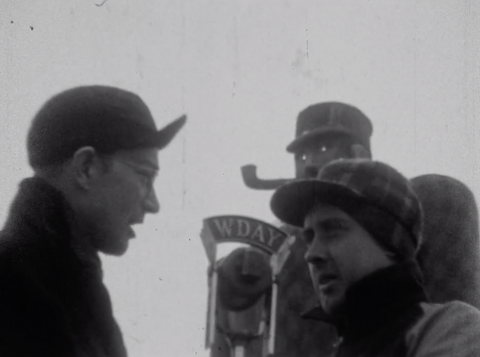History of Bemidji's Paul Bunyan and Babe.
In honor of Paul Bunyan Day, we're digging up the history of our hometown legends. The following write-up is taken from the 1988 National Register of Historic Places Inventory-Nomination Form.
"Minnesota's first and best-known example of "the roadside colossus," the statuary grouping of Paul Bunyan and Babe the Blue Ox is historically significant for their role in promoting tourism in northern Minnesota.
 Located in a vast woodland and lake region, the City of Bemidji played host to a modest tourist: trade as early as the 1890s, After the establishment of rail connections in 1898, promoters began developing lakeshore sites for summer cottages and constructing a variety of tourist hotels and resorts, primarily catering to hunters and fishermen. Benefiting still further from the emergence of the automobile and a state-sponsored highway system, the Bemidji tourist industry boomed during the 1920s but then suffered along with the rest of the economy during the Great Depression. In 1936, as a means of stimulating tourism, a number of Bemidji civic organizations and businesses decided to sponsor a winter carnival that would promote the city's resources for winter sports. During the previous year, the city had constructed, with WPA assistance, a large winter sports arena, containing facilities for indoor ice skating, hockey, and curling. Although winter was traditionally the region's "off" season, the carnival's organizers hoped that the four days of planned festivities would show that "Minnesota can exploit its winter attractions in a way which will draw thousands of tourists in the winter months as well as in the summer season."
Located in a vast woodland and lake region, the City of Bemidji played host to a modest tourist: trade as early as the 1890s, After the establishment of rail connections in 1898, promoters began developing lakeshore sites for summer cottages and constructing a variety of tourist hotels and resorts, primarily catering to hunters and fishermen. Benefiting still further from the emergence of the automobile and a state-sponsored highway system, the Bemidji tourist industry boomed during the 1920s but then suffered along with the rest of the economy during the Great Depression. In 1936, as a means of stimulating tourism, a number of Bemidji civic organizations and businesses decided to sponsor a winter carnival that would promote the city's resources for winter sports. During the previous year, the city had constructed, with WPA assistance, a large winter sports arena, containing facilities for indoor ice skating, hockey, and curling. Although winter was traditionally the region's "off" season, the carnival's organizers hoped that the four days of planned festivities would show that "Minnesota can exploit its winter attractions in a way which will draw thousands of tourists in the winter months as well as in the summer season."

The carnival opened on January 14, 1937. Taking its theme from the city's former prominence as a lumbering center, the celebration focused on the mythical figure of Paul Bunyan a giant lumberjack of redoubtable endurance and skill who, during the mid-nineteenth century, had migrated with the folklore of the lumber camps from New England to Minnesota. The Bemidji carnival was not the first attempt to commercialize the Bunyan legend. As early as 1914, one of Minnesota's leading logging concerns, the Red River Lumber Company, had published a pamphlet using the Bunyan fables to promote nationally the company's wood products. The pamphlet was the work of copywriter and ex-lumberjack W. B. Laughead, who embellished the original folk tales' by emphasizing Bunyan's Minnesota exploits and by christening his previously anonymous quadruped companion as "Babe the Blue Ox." Revised and reissued in succeeding decades, the advertising piece helped make Paul and Babe national celebrities.
 The Bemidji winter carnival, however, did have a unique promotional twist. It unveiled giant concrete statues of Paul and Babe to serve as mascots for the festivities. Both statues were designed and built by city residents. Cyril M. Dickinson of the Dickinson Construction Co. was "the mastermind" behind the Bunyan figure, while Jim Payton, manager of the local power company, supervised the construction of Babe, Both statues became overnight tourist sensations, garnering a full-page spread in Life Magazine. Although the Bunyan statue established immediate residence at its present location in a municipal park overlooking the city's busiest intersection, Babe initially led a more adventuresome existence. Mounted on a Model T Ford automobile, it paraded through Bemidji during the carnival and then, the next month, journeyed to St. Paul to take part in that city's winter festival. In the summer of 1937, Babe returned to the Twin Cities as a guest of the State Fair. Finally, in 1938, the statue was dismantled from its mobile chassis and placed on permanent display in Bemidji next to the figure of Paul Bunyan.
The Bemidji winter carnival, however, did have a unique promotional twist. It unveiled giant concrete statues of Paul and Babe to serve as mascots for the festivities. Both statues were designed and built by city residents. Cyril M. Dickinson of the Dickinson Construction Co. was "the mastermind" behind the Bunyan figure, while Jim Payton, manager of the local power company, supervised the construction of Babe, Both statues became overnight tourist sensations, garnering a full-page spread in Life Magazine. Although the Bunyan statue established immediate residence at its present location in a municipal park overlooking the city's busiest intersection, Babe initially led a more adventuresome existence. Mounted on a Model T Ford automobile, it paraded through Bemidji during the carnival and then, the next month, journeyed to St. Paul to take part in that city's winter festival. In the summer of 1937, Babe returned to the Twin Cities as a guest of the State Fair. Finally, in 1938, the statue was dismantled from its mobile chassis and placed on permanent display in Bemidji next to the figure of Paul Bunyan.
 Some fun facts to note: If you look closely at the current Paul Bunyan Statue and pay close attention to his eyes you'll notice something interesting. Paul's eyes are actually made of bulbs (probably from an automobile) and were originally lit so that they glowed as you'll see in this 1939 picture. Also according to the Historic Nomination form, Paul's statue was equipped with a public address system, presumably so that he could "talk." Not creepy at all! Today, a closer look at the Babe statue will reveal his adventurous, traveling past. Inside his nostrils, the original exhaust pipes are still visible where the exhaust from his vehicle was vented. And a closer look at his eyes shows that, like Paul, Babe's eyes were probably glowing at some point too - red reflectors are still visible.
Some fun facts to note: If you look closely at the current Paul Bunyan Statue and pay close attention to his eyes you'll notice something interesting. Paul's eyes are actually made of bulbs (probably from an automobile) and were originally lit so that they glowed as you'll see in this 1939 picture. Also according to the Historic Nomination form, Paul's statue was equipped with a public address system, presumably so that he could "talk." Not creepy at all! Today, a closer look at the Babe statue will reveal his adventurous, traveling past. Inside his nostrils, the original exhaust pipes are still visible where the exhaust from his vehicle was vented. And a closer look at his eyes shows that, like Paul, Babe's eyes were probably glowing at some point too - red reflectors are still visible.
1988 National Register of Historic Places Inventory-Nomination Form, Minnesota Historical Society, http://www.mnhs.org
Images from The Paul Bunyan Winter Carnival 1939 a video from the Beltrami County Historical Society by Nik Nerburn of his work on Under the Shadow of Paul Bunyan.






I remember as a child in the early 1950s going on vacation from our home in Des Moines to Bemidji. As children in the car when we saw the statues of Paul Bunyon and Babe we knew we were close to our destination.
In the 70’s – there used to be a carnival during the summer months by the statues. I spent my birthday at the carnival just about every year….. Have many many pics of me with those statues. And riding the Ferris wheel with them in the background. Fun times!
I never tire of hearing this story. Cyril Dickinson was my great-uncle, my Grandpa Leonard Dickinson’s brother. Another bit of Paul Bunyan trivia. As they were building Paul, he was upright in a building at the future Dickinson Lumber Company between Lake Bemidji and Lake Irving. His upper body was up in the rafters, and the building was poorly lit. Thus, the reason his shoulders are not symetrical. I think only we Dickinson’s knew this story until now!
Love this! Great write up!
Leave a comment